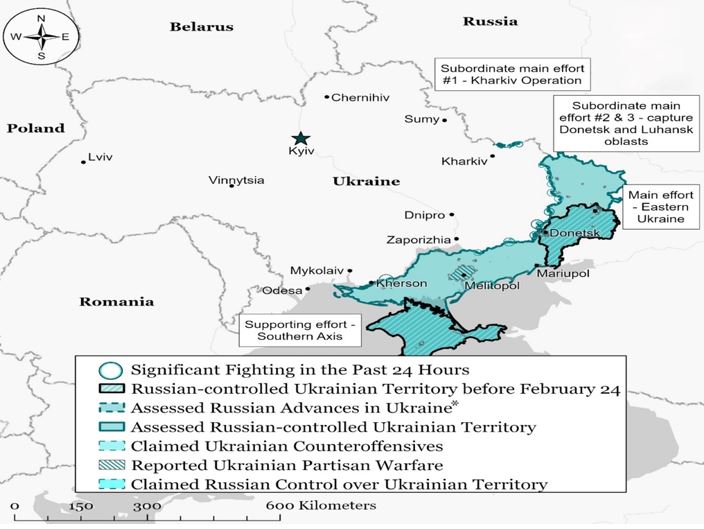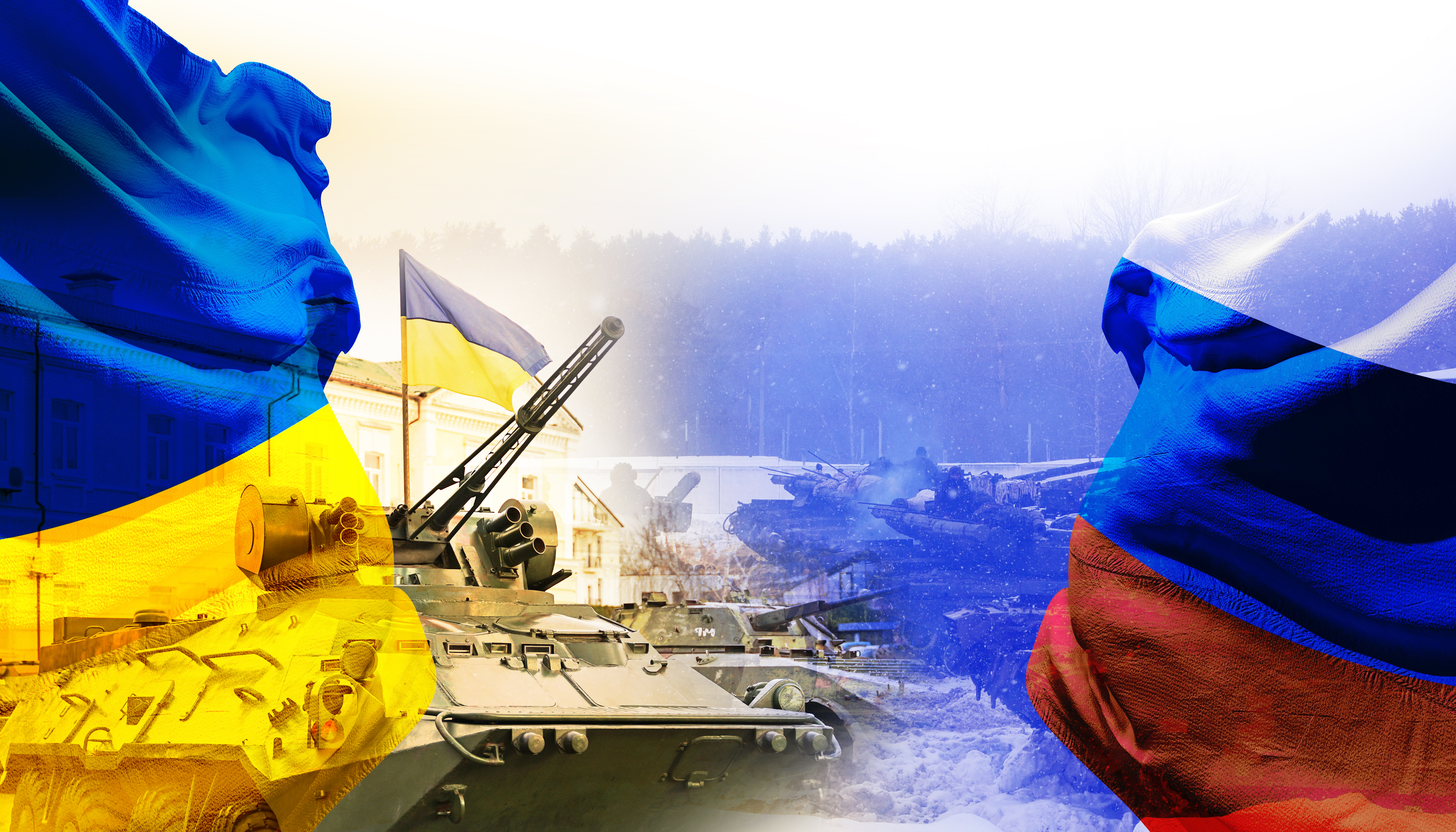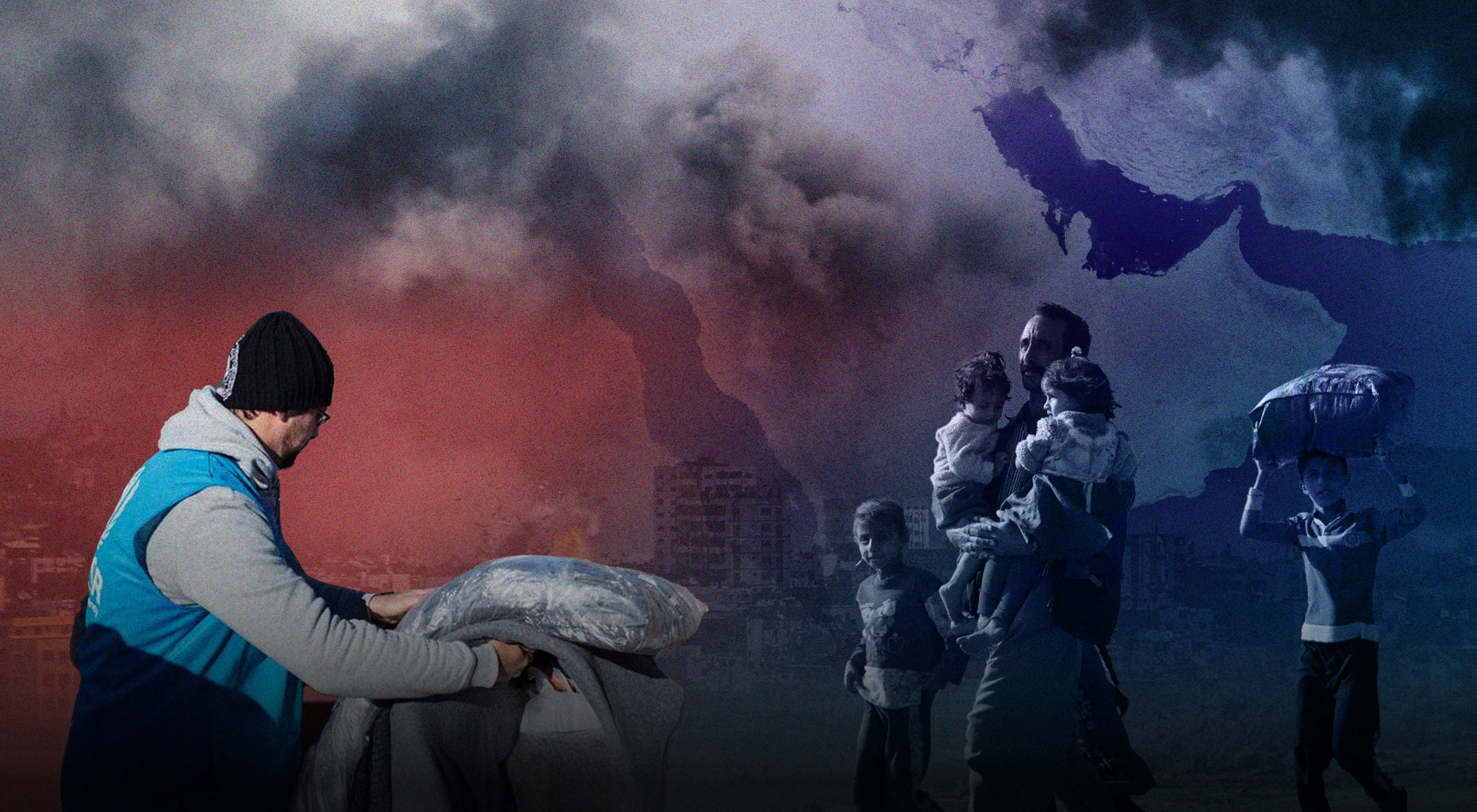Introduction
On 10 May 2024, Russia launched a massive surprise offensive along the northeastern front, centered in Kharkiv province. This offensive will undoubtedly have a significant impact on the future of the Russia-Ukraine war. There is a risk of direct conflict between Russia and NATO.
This paper examines the potential of the latest Russian offensive in Kharkiv and its ramifications for the Russian-Ukrainian war. In order to achieve this, the paper first examines the objectives and development of the recent Russian offensive on the Northeastern front. The study also looks into how Ukraine responded to the Russian attack and maneuver. Third, the paper evaluates the key takeaways of the Russian offensive and explores how it may affect the ongoing conflict between Russia and Ukraine.
New Russian Offensive in Northeastern Front
A combined force of 40,000 Russian troops launched a cross-border assault on 10 May in Kharkiv province, opening a new “northeastern” front in the over-two-year-long war. Kharkiv, home to about 1.3 million people, is located about 30 kilometers from the Russian border.[1]
The Russian offensive seeks to draw and fix Ukrainian forces and create opportunities for Russian forces elsewhere in the theater, specifically in Donetsk province.[2] This is why some military experts call it a maneuver, not really a new offensive. Russian forces aim to push Ukrainian forces back from the international border with Belgorod province and approach within the tube artillery range of Kharkiv City.[3] The pattern and direction of Russian military operations since the beginning of the offensive indicate that they are prioritizing the creation of a “buffer zone” along the international border in Kharkiv province over deeper penetration. This was later confirmed by President Vladimir Putin and other Kremlin officials, stressing that there were no plans to capture the city.[4] The objective of establishing such a zone is to protect Russian territory from Ukrainian strikes. According to Ukrainian and Western officials, the Russian intended buffer zone’s size is 10km.[5]
Thousands of Ukrainian civilians were forced to evacuate combat zones as a result of the Kharkiv offensive, and an unspecified number of Ukrainian forces were forced to withdraw. On the other hand, Russian forces made significant tactical gains in northern Kharkiv as they have taken territory of about 100 sq. km,[6] Russia’s biggest territorial gains in Ukraine since late 2022.[7]
Even though fighting is still going on, the Russian offensive’s pace has slowed after the previously stated initial gains, and Russian progress in the Kharkiv direction has largely stalled.[8] Russian forces are attempting to take control of the key towns of Vovchansk and Lypsti. Securing Vovchansk, a town about 4km from the border and 45km northeast of Kharkiv, would enable Russian forces to target neighboring Donetsk and capture the entirety of the province.[9] Capturing Lyptsi, which lies around 30km north of Kharkiv, would allow Russian troops to position artillery within range of Kharkiv city, Ukraine’s second largest.[10]
Although Russia’s offensive in Kharkiv has grabbed public attention, Moscow continues to focus its main effort on taking the rest of the Donbas region. While the tempo of the Kharkiv offensive has decreased, as has been illustrated before, the Russian forces are intensifying their attacks on the eastern front.[11]
Its forces have achieved incremental gains on the eastern front over the past weeks, most notably near the militarily significant city of Chasiv Yar, about 8km west of Bakhmut. Seizing Chasiv Yar would enable Russian forces to control the entire Donetsk province and the Donbas region, a main goal of Russia.[12] Russia has also managed to gain some ground west of Avdiivka, southwest of Donetsk City and near Siversk.[13]
While Russia’s advances have been minor, the situation is unstable due to Ukraine’s manpower shortage, and the Kharkiv offensive has further stretched Ukrainian forces.[14]
Russian forces have recently intensified their combined drone and missile strikes against Ukrainian military and civilians, particularly energy, and infrastructure in the rear and on the frontlines and continue efforts to exhaust Ukraine’s scarce air defense assets. According to The Financial Times, Russia has destroyed or seized over half of Ukraine’s power generation capacity and, therefore, caused widespread blackouts and concerns about future energy supplies.[15] Russia will likely continue periodic large-scale strikes against energy infrastructure to cause significant long-term damage that impairs Ukraine’s ability to wage war and create an environment that will intensify humanitarian crises during the winter of 2024-2025.[16]
Areas of Russian Control in Ukraine

Source: Institute for the Study of War, 7 June 2024, https://zip.lu/3jzEx.
Ukrainian and Western Response to Russian Offensive and Maneuver
Ukraine responded to the Russian offensive in Kharkiv with a combination of strategic military preparedness and immediate defensive actions.[17] President Volodymyr Zelensky said that the Ukrainian military had anticipated the Russian attack.[18] In preparation, Ukrainian forces had strategically positioned troops, brigades, and artillery in the northeastern region. This foresight allowed Ukraine to mount an organized and effective defense against the Russian incursion. Once the Russian offensive started, Ukraine had to divert troops and arms from other parts of the front line in the Donetsk and Luhansk regions. Ukrainian forces are engaging in intense fighting to fend off the Russian assault, which is focusing on the Lyptsi axis and in Vovchansk. The fighting has turned to close combat, with units fighting street by street. While their advance has slowed, Russian forces continue to press along the new front line in the north. Ukrainian forces face structural problems related to its limited manpower resources, exhaustion among troops, and electronic warfare. They are being stretched along the 1,000km long front line.[19]
The Ukrainian campaign on Russian energy, industrial defense and military facilities energy and logistic infrastructure within Crimea and Russia, including Belgorod, Rostov provinces, and Krasnodar Krai.[20]
Following the Russian offensive, the U.S. and other Western countries stepped up their efforts to bolster Ukraine’s defense capabilities and counter the Russian military offensive. European countries, including France and Germany, allowed Kyiv to strike targets within Russia.[21] The U.S. permitted Ukraine to use its weaponry to strike inside Russia for the limited purpose of defending Kharkiv.[22] The Ukrainian forces have already attacked targets within Russia using U.S. long-range missiles, particularly ATACMS and likely HIMARS missiles. In response, President Putin threatened that Russia would provide long-range strike capabilities to unspecified actors for strikes against the West. Putin’s threat aims to influence Western decision-making about Ukraine’s ability to strike military targets within Russia using Western-provided weapons.[23]
Several Western countries, including Spain, Sweden, Iceland, and Norway, signed long-term bilateral security agreements with Ukraine stipulating that they would provide Ukraine with additional large military assistance packages.[24] In addition, the U.S., Germany, and Poland announced additional large military assistance packages for Ukraine. France announced it may send military trainers to Ukraine and will provide Ukraine with an unspecified number of Mirage 2000-5 fighters.[25]
Assessment and Prospects of the Russian Offensive
The offensive has achieved some success in its likely objective of compelling Kyiv to divert forces badly needed elsewhere, particularly on the eastern front.[26] Russia may well launch another, smaller offensive in Sumy Province to further stretch Ukrainian forces. This is why some analysts assess that the Russian offensive appeared to have limited operational objectives, focusing on tactical gains rather than a large-scale operation to seize major cities like Kharkiv.
Russian forces continued offensive operations in the northeastern front, especially in the Lyptsi direction and near and within Vovchansk, but there was no breakthrough to the frontline. Ukrainian forces fully control central and eastern Vovchansk (75%), but Russian forces control a large part of northern Vovchansk. Russia likely hopes that attrition and sustained pressure on multiple fronts will eventually lead Ukrainian lines to collapse somewhere along the eastern front.[27]
It seems that the course of the military engagements on the northern-eastern front has been taking the form of positional engagements. A positional war is characterized by relatively static frontlines and regular combat that produces little movement. The aim of such combat is generally either to create forward progress through steady, if small, advances or to create conditions to restore maneuver to the battlefield.[28]
After allowing Ukrainian forces to use the U.S.-provided weaponry to strike targets inside Russia, as previously explained, the Russian main objective of creating a buffer zone along the northern international border became meaningless. Russia’s Belgorod Province will remain under threat from Ukrainian attacks. Within hours of U.S. President Joe Biden changing the policy, Ukrainian HIMARS bombarded Belgorod.[29]
This coordinated and multifaceted Ukrainian response highlights the country’s resilience and the essential role of international assistance in bolstering its defense efforts amid the ongoing conflict with Russia. The combination of preparedness, robust defensive actions, and international military aid underscores the comprehensive approach Ukraine has adopted to counter the Russian threat effectively.
However, the sustained bombing campaign against the northeastern Ukrainian city of Kharkiv has made life increasingly difficult and dangerous for civilians. Most of the energy infrastructure has been severely damaged in the city.[30]
Conclusion
The Ukraine war is unlikely to end soon. Fighting is raging on the three (eastern, northeastern, and southern) fronts, albeit to varying degrees.
The escalation of fighting is likely to dominate the course of the war in the coming months due to several factors. First, Russia attempts to exploit ongoing constraints on Ukrainian air defenses. Second, Russian forces are trying to make tactically and operationally significant gains before U.S. military assistance arrives to Ukrainian forces at the frontline at scale.[31] Third, the initial arrival of U.S. and Western military assistance to frontline areas would enable Ukrainian forces to counter the Russian offensive and allow them to fully challenge the Russian military’s current artillery shell advantage.[32] Fourth, permitting Ukraine to use Western weapons to strike military targets in Russia will play a critical role in Ukraine’s future counteroffensive operations.
Russia tries to drag the war for as long as possible in order to damage Ukraine’s economy, lower its spirits, and exhaust its European allies. President Putin believes that Russian forces will be able to continue incremental, gradual advances indefinitely, prevent Ukraine from launching counteroffensives, and win a war of attrition against Ukrainian forces.[33] Much like they did after they signed the Minsk agreements, which essentially put an end to the “hot phase” of the Donbas war, Russia and Ukraine may remain engaged in low-level positional warfare for years to come.
[1] Samya Kullab and Elise Morton, “Zelenskyy says Ukraine has taken back control in areas of embattled Kharkiv region,” ABC News, May 25, 2024, https://zip.lu/3jycT.
[2] Carlotta Gall and Vladyslav Golovin, “Drones have offered Last Line of Defense for a Strategic Ukrainian Town,” The New York Times, May 25, 2024, https://zip.lu/3jyQc.
[3] George Barros, “Russia’s Kharkiv Operation Requires Eliminating Russia’s Sanctuary,” Institute of the Study of War (ISW), May 13, 2024, https://zip.lu/3jycP; ISW, “Russian Offensive Campaign Assessment,” June 5, 2024, https://zip.lu/3jydf.
[4] “Putin Says Russian Offensive in Ukraine’s Kharkiv Region Aims to Create Buffer Zone but No Plans to Capture City.” ABC News, May 17, 2024, https://zip.lu/3jyfk.
[5] ISW, “Russian Offensive Campaign Assessment,” May 21, 2024, https://zip.lu/3jeCX.
[6] Kullab and Morton, “Zelenskyy says Ukraine”.
[7] Méheut, “Ukraine Steps Up.”
[8] Hardie, “As Ukrainian Forces.”
[9] Barros, “Russia’s Kharkiv Operation”; ISW, “Russian Offensive Campaign Assessment,” June 5, 2024, https://zip.lu/3jydf.
[10] Lou Robinson and Sophie Tanno, “Russia opens a new front: Mapping three key battles in the Ukrainian war,” CNN, June 1, 2024, https://zip.lu/3jzwL.
[11] John Hardie, “As Ukrainian Forces Flow to Kharkiv, Russia Inches Forward at Chasiv Yar,” FDD’s Long War Journal,” FDD’s Long War Journal, May 24, 2024. https://zip.lu/3jyPH.
[12] Gall and Golovin, “Drones have offered”; Hardie, “As Ukrainian Forces.”
[13] ISW, “Russian Offensive Campaign,” June 6, 2024.
[14] John Hardie, “As Ukrainian Forces Flow to Kharkiv, Russia Inches Forward at Chasiv Yar,” May 25, 2024, https://zip.lu/3jyPH.
[15] “Russia Has Taken Out Over Half of Ukraine Power Generation,” Financial Times, June 5, 2024, https://www.ft.com/content/4d583259-7565-4cbc-972e-ea77f4a76175.
[16] ISW, “Russian Offensive Campaign,” June 5, 2024.
[17] “Russia launches Kharkiv ground offensive,” DW, May 10, 2024, https://zip.lu/3jzJt.
[18] “Zelensky vows to quash new Russian offensive in Ukraine’s Kharkiv region,” France 24, May 10, 2024, https://zip.lu/3jAGw.
[19] Svitlana Vlasova, Daria Markina Tarasova and Victoria Butenko, “Ukraine stabilizes the north after surprise Russian push – but faces fresh pressure in the east,” CNN, June 8, 2024, https://zip.lu/3jAHu; ISW, Russian Offensive Campaign Assessment, May 10, 2024, https://zip.lu/3jzJN.
[20]Constant Méheut, “Ukraine Steps Up Attacks with U.S. Long-Range Missiles,” The New York Times, May 25, 2024, https://zip.lu/3jyvZ; ISW, “Russian Offensive Campaign Assessment,” June 06, 2024, https://zip.lu/3jyS5.
[21] Vlasova, Tarasova and Butenko, “Ukraine stabilizes the north.”
[22] Despite the lack of clarity about U.S. restrictions on Ukraine’s use of U.S.-provided weapons to strike military targets in Russian territory, there is a wide agreement among commentators that Ukrainian forces are restricted to the border area in Kharkiv province when using U.S.-provided weapons. The current lack of clarity about U.S. restrictions on Ukraine’s use of U.S.-provided weapons to strike military targets in Russian territory misses an opportunity to deter further Russian offensive efforts across the border into northern Ukraine. ISW, “Russian Offensive Campaign Assessment,” May 31, 2024, https://zip.lu/3jyyi; Andrew E. Kramer, “On Northern Border, Permission to Fire into Russia Buoys Ukraine,” The New York Times, May 31, 2024, https://zip.lu/3jyNQ.
[23] ISW, “Russian Offensive Campaign,” June 6, 2024.
[24] ISW, “Russian Offensive Campaign Assessment,” May 31, 2024, https://zip.lu/3jyyi.
[25] ISW, “Russian Offensive Campaign Assessment,” June 7, 2024, https://zip.lu/3jzEx; ISW, “Russian Offensive Campaign,” June 6, 2024.
[26] Hardie, “As Ukrainian Forces.”
[27] David Axe, “Putin’s ‘Victory Day’ offensive in northern Ukraine has backfired spectacularly,” The Telegraph, June 5, 2024, https://zip.lu/3jysE; Hardie, “As Ukrainian Forces.”
[28] Pieter Garicano, Grace Mappes, and Frederick W. Kagan, “Positional Warfare in Alexander Svechin’s Strategy,” Institute for the Study of War, March 29, 2024, https://shorturl.at/qs012.
[29] Axe, “Putin’s ‘Victory Day’”.
[30] Constant Méheut, “Russia Bombs Hardware Superstore in Kharkiv, killing 12, Ukraine Says,” The New York Times, May 25, 2024, https://zip.lu/3jySq.
[31] ISW, “Russian Offensive Campaign,” June 5, 2024
[32] Ben Farmer, “‘We Need to Kill them, so They Don’t Come Here’: Ukrainian Troops Celebrate Chance to Strike Russia,” The Telegraph, June 5, 2024. https://www.telegraph.co.uk/world-news/2024/06/05/ukraine-soldiers-russian-territory-joe-biden/.
[33] ISW, “Russian Offensive Campaign Assessment,” June 7, 2024, https://zip.lu/3jzEx.









